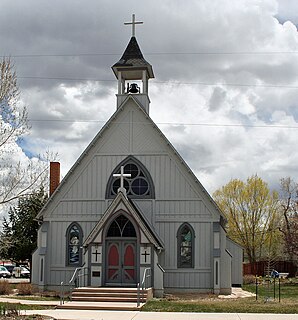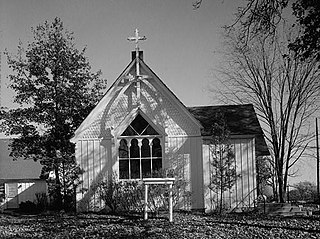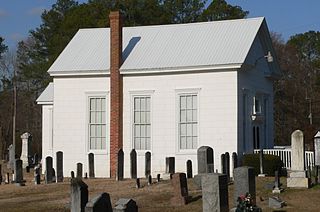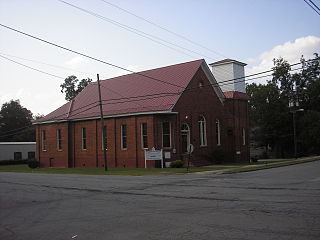
Grace Episcopal Church is an historic Carpenter Gothic church in Georgetown, Colorado. Built in 1870, it now overlooks Interstate 70. Grace Episcopal is still an active church in the Episcopal Diocese of Colorado. On August 14, 1973, the church was added to the National Register of Historic Places.

Grace United Methodist Church is a historic church donated to the people of St. Augustine, Florida, by American industrialist Henry Morrison Flagler. It is located at 8 Carrera Street. Built within a one-year span, it was added to the U.S. National Register of Historic Places on November 29, 1979, for its architectural significance and as an example of community planning.

St. Luke's Episcopal Church and Cemetery is an historic Carpenter Gothic style Episcopal church building built in 1888 and its adjacent cemetery located at 5555 North Tropical Trail, in Courtenay, on Merritt Island, Brevard County, Florida, in the United States. On June 15, 1990, St. Luke's and its cemetery were added to the National Register of Historic Places as Old St. Luke's Episcopal Church and Cemetery.

Bethany Memorial Chapel was built by Norwegian homesteaders who settled in the Big Bear Ridge area north of Kendrick in rural Latah County, Idaho. Norwegians who had settled in the area met at the home of Edward Dahl on July 21, 1902, for the purpose of organizing a Lutheran church in the area. In late July 1902, plans were prepared for the building, which was to be constructed on one-half acre of land promised by Edward Jones. However, Jones had sold his land to Halvor Nelson, who then added another one-half acre to the property. Construction of the Carpenter Gothic building began in 1905 and was completed, inside and out, in 1908. Although the interior of the building had not yet been completed, the first service in the church took place on December 26, 1905, when Halvor Lien married Hilda Slind. The pews, altar railing, and pulpit were carved by Eric Leien, a member of the congregation. It was originally named the Evangelical Lutheran Church, Bethany Congregation of Kendrick. There is no longer an active congregation holding services, but the church and cemetery are maintained by community members.

All Saints Episcopal Church, built in 1872–1873, is an historic Carpenter Gothic church in Saugatuck, Michigan. On February 27, 1984, it was added to the National Register of Historic Places.

Charles Street African Methodist Episcopal Church is an historic African Methodist Episcopal Church at 551 Warren Street in Boston, Massachusetts. The current church building was built in 1888 by J. Williams Beal and added to the National Register of Historic Places in 1983.

Bardsdale United Methodist Church is a historic church located at 1498 Bardsdale Avenue in the unincorporated community of Bardsdale, California, in Ventura County. It is south of the Santa Clara River approximately 3 miles (5 km) from Fillmore.

The Central Mine Methodist Church is a church located on Old Stage Road in Central, Michigan, in the Central Mine Historic District. It is one of the few structures being maintained in this nearly deserted mining town. It was listed on the National Register of Historic Places and designated a Michigan State Historic Site in 1970.

The Methodist Episcopal Church is a historic church and parsonage at 61 East Putnam Avenue in Greenwich, Connecticut. Built in 1868-69 for a Methodist congregation established in 1805, the church is a fine local example of Carpenter Gothic architecture, and the parsonage, built in 1872, is a good example of Italianate architecture. The property was listed on the National Register of Historic Places in 1988. The congregation is affiliated with the United Methodist Church.

Old Christ Church is a historic Episcopal church at the junction of Vermont Route 12 and Gilead Brook Road in Bethel, Vermont. Built in 1823, it is a well-preserved Federal period church, lacking modern amenities such as electricity and plumbing. The church was added to the National Register of Historic Places in 2008. It is used for services only during the summer.

The Saint Michael and All Angels Episcopal Church is a historic church located in rural Cambridge Township in northwestern Lenawee County, Michigan. The church was designated as a Michigan Historic Site on October 2, 1980. On February 4, 2004, the church, along with the adjacent Cambridge Township Cemetery, was added to the National Register of Historic Places.

St. John's Episcopal Church is a parish church in the Episcopal Diocese of Iowa. It is located in Keokuk, Iowa, United States. It was listed, together with the parish hall, on the National Register of Historic Places in 1989.

St. Barnabas Episcopal Church is a former church building in the Episcopal Diocese of Iowa located in Montrose, Iowa, United States. It was listed on the National Register of Historic Places in 1986. The building is now called St. Barnabas Wedding Chapel.

Grace Church, formerly the Grace Episcopal Church, is a historic Carpenter Gothic style church building located in Buena Vista, Chaffee County, Colorado. Originally built as an Episcopal church in 1889 by the Lannan Brothers, its Carpenter Gothic details include board and batten siding, lancet windows and door openings and buttresses. On January 20, 1978, it was added to the National Register of Historic Places. On February 7, 2007, the church received of the Colorado Historic Society's 21st Annual Stephen H. Hart Awards for its restoration of the interior and exterior of the building.

St. Katherine's Chapel, also known as St. Katherine's Episcopal Chapel, is an historic Episcopal church building located at 4650 North Meridian Road in Williamston Township, near Williamston, Michigan.

The First Methodist Episcopal Church, also known as the Red Church, is a historic church located at 4451 Second Street in Port Hope, Michigan. It was listed on the National Register of Historic Places in 1987.

McColley's Chapel is a Methodist chapel located between Ellendale and Georgetown, Delaware. It was listed on the National Register of Historic Places on November 30, 2011.

St. Thomas African Methodist Episcopal Church is a historic African-American church in Hawkinsville, Georgia, located at 401 North Dooly Street. It is a large brick building on the northwest corner of North Dooly Street and Second Street, built 1908-1912, replacing a wood building built in 1877. Some of its historical integrity was lost due to non-historic additions and alterations. Restrooms were added in the 1950s, ceiling tiles in the 1960s, carpeting in 1982, interior partitions and new windows in 1987, new steps in 1988, and new pews and air conditioning in 1989. It has a steeply pitched gable-front roof. The interior has an open space with a pulpit, with three sections of pews. It is one of the last remaining buildings of a historically African-American neighborhood and was the largest and only brick building in the neighborhood.

Roberts Park Methodist Episcopal Church, whose present-day name is Roberts Park United Methodist Church, was dedicated on August 27, 1876, making it the oldest church remaining in downtown Indianapolis. Diedrich A. Bohlen, a German-born architect who immigrated to Indianapolis in the 1850s, designed this early example of Romanesque Revival architecture. The church is considered one of Bohlen's major works. Constructed of Indiana limestone at Delaware and Vermont Streets, it has a rectangular plan and includes a bell tower on the southwest corner. The church is known for its interior woodwork, especially a pair of black-walnut staircases leading to galleries (balconies) surrounding the interior of three sides of its large sanctuary. The church was added to the National Register of Historic Places on August 19, 1982. It is home to one of several Homeless Jesus statues around the world, this one located behind the church on Alabama Street.

Evergreen Conference District is a music conference center in Jefferson County, Colorado, near Evergreen. It was listed as a historic district on the National Register of Historic Places on May 1, 1979. The district is located at Highway 74 along Bear Creek.






















